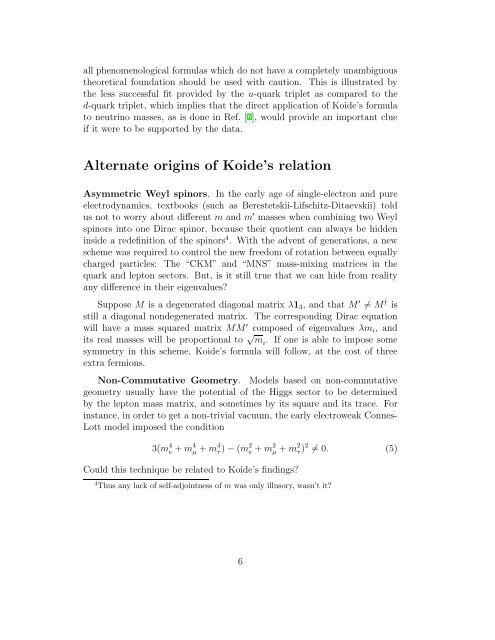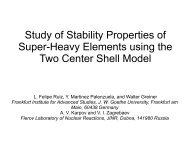The strange formula of Dr. Koide
The strange formula of Dr. Koide
The strange formula of Dr. Koide
You also want an ePaper? Increase the reach of your titles
YUMPU automatically turns print PDFs into web optimized ePapers that Google loves.
all phenomenological <strong>formula</strong>s which do not have a completely unambiguous<br />
theoretical foundation should be used with caution. This is illustrated by<br />
the less successful fit provided by the u-quark triplet as compared to the<br />
d-quark triplet, which implies that the direct application <strong>of</strong> <strong>Koide</strong>’s <strong>formula</strong><br />
to neutrino masses, as is done in Ref. [7], would provide an important clue<br />
if it were to be supported by the data.<br />
Alternate origins <strong>of</strong> <strong>Koide</strong>’s relation<br />
Asymmetric Weyl spinors. In the early age <strong>of</strong> single-electron and pure<br />
electrodynamics, textbooks (such as Berestetskii-Lifschitz-Ditaevskii) told<br />
us not to worry about different m and m ′ masses when combining two Weyl<br />
spinors into one Dirac spinor, because their quotient can always be hidden<br />
inside a redefinition <strong>of</strong> the spinors 4 . With the advent <strong>of</strong> generations, a new<br />
scheme was required to control the new freedom <strong>of</strong> rotation between equally<br />
charged particles: <strong>The</strong> “CKM” and “MNS” mass-mixing matrices in the<br />
quark and lepton sectors. But, is it still true that we can hide from reality<br />
any difference in their eigenvalues?<br />
Suppose M is a degenerated diagonal matrix λ1 3 , and that M ′ ≠ M † is<br />
still a diagonal nondegenerated matrix. <strong>The</strong> corresponding Dirac equation<br />
will have a mass squared matrix MM ′ composed <strong>of</strong> eigenvalues λm i , and<br />
its real masses will be proportional to √ m i<br />
. If one is able to impose some<br />
symmetry in this scheme, <strong>Koide</strong>’s <strong>formula</strong> will follow, at the cost <strong>of</strong> three<br />
extra fermions.<br />
Non-Commutative Geometry. Models based on non-commutative<br />
geometry usually have the potential <strong>of</strong> the Higgs sector to be determined<br />
by the lepton mass matrix, and sometimes by its square and its trace. For<br />
instance, in order to get a non-trivial vacuum, the early electroweak Connes-<br />
Lott model imposed the condition<br />
3(m 4 e + m4 µ + m4 τ ) − (m2 e + m2 µ + m2 τ )2 ≠ 0. (5)<br />
Could this technique be related to <strong>Koide</strong>’s findings?<br />
4 Thus any lack <strong>of</strong> self-adjointness <strong>of</strong> m was only illusory, wasn’t it?<br />
6



